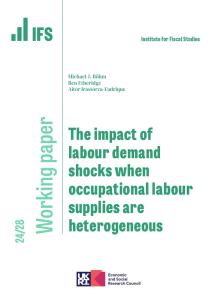Recommended salary levels for further education college teachers in England fell by 18% in real terms between 2010–11 and 2022–23. This compares with real-terms falls of up to 13% for school teachers.
These large falls in college teacher salaries seem to have translated into major retention issues. Almost a quarter of college teachers leave the profession within a year and around half have left the profession within three years of starting.
These are some of the key findings of the new report ‘What has happened to college teacher pay in England?’ by researchers at the Institute for Fiscal Studies, published today and funded by the Nuffield Foundation as part of a wider programme of work looking at trends and challenges in education spending.
The new analysis on pay covers 50,000 college teachers in further education colleges in England, which does not include teachers in sixth forms. College teachers are mainly responsible for teaching vocational qualifications for young people and adults, such as BTECs, and cover a wide range of subject areas, from basic literacy to childcare, catering and engineering. The analysis on retention rates covers teachers in sixth-form colleges and general further education colleges.
Unlike school teacher pay which is set at the national level, college teacher pay is set by individual colleges. However, college leaders in England decide salary levels based on annual pay recommendations made by the Association of Colleges (AoC). Since 2010, the AoC has recommended below-inflation pay increases in all but two academic years. These pay recommendations imply an 18% reduction in college teacher salary levels.
Other key findings include:
Both school and college teachers have experienced significant real-terms salary declines
- Between 2010–11 and 2022–23, recommended pay levels for college teachers have fallen by 18% in real terms. In the same period, school teachers have seen their recommended pay scales fall by between 5% and 13% depending on their level of experience.
- There have been especially sharp real-terms declines in college teacher pay this year. With inflation at around 10%, college teachers in England were offered a 2.5% pay increase this academic year plus a non-consolidated cost-of-living payment of between £500 and £750 for lower-paid staff. This compares with rises of more than 5% for school teachers.
- College teachers receive a higher starting salary than school teachers but the gap in starting salaries has narrowed. Since 2010, starting salaries have decreased by 14% for college teachers and by 5% for school teachers. As a result, a new college teacher today earns around £29,000 compared with £28,000 for a new school teacher. New college teachers have gone from earning around 15% more, on average, than school teachers to around 4% more.
- In September, starting salaries for school teachers are set to rise to £30,000. This means that next year, anew school teacher is likely to earn more than the average new college teacher for the first time on record.
- On average, school teachers earn 21% more than college teachers,and the gap has grown over time. Between 2010–11 and 2022–23, median salaries for school teachers fell by 14% in real terms, while the median salary for college teachers fell by 19%. These falls in median salaries are slightly larger than those in pay scales, which is likely to reflect the changing composition of the workforces over time. The net result is that the gap in median salaries between college and school teachers has grown from 14% in 2010 to 21% in 2022.
Staff turnover is higher within colleges than in schools and many other public sector organisations
- Around 25% of college teachers leave the profession after one year compared with 15% of school teachers. Three years in, almost half of college teachers have left compared with around a quarter of school teachers. Ten years after beginning teaching, less than a quarter of college teachers remain in the profession compared with over 60% of school teachers.
- The exit rate among college staff (i.e. the share leaving the profession each year) is high relative to other public sector occupations: 16% of college teachers exit the profession each year, compared with 10% of school teachers, 10–11% across most NHS occupations and 7–8% in the civil service.
Cuts to post-16 education funding make it difficult for college leaders to allocate more money to higher pay levels. Between 2010–11 and 2019–20, public spending per student aged 16–18 declined by 14% in colleges, while spending on classroom-based adult education almost halved. Although additional funding has been allocated in recent spending reviews, this only partially reverses the cuts that took place up to 2020.
Imran Tahir, IFS research economist and an author of the report, said: ‘A lot of focus in recent times has been on school teachers strikes, while the plight of the college workforce has largely gone under the radar. Many of the issues faced by school teachers are even more acute among college teachers. College teachers have seen their pay fall by 18% in real terms compared with up to 13% for school teachers, and almost half leave the profession within three years of starting. College leaders face a perpetual challenge of recruiting new staff and finding money within already stretched budgets to retain existing staff. Large real-terms cuts to funding and college teacher pay, combined with low levels of retention, will make it that much harder to deliver on the government’s high ambitions for technical education.’
Josh Hillman, Director of Education at the Nuffield Foundation, said: ‘Colleges play a critical role in supporting more than 1.7 million students in England every year with the core technical and vocational skills that support them to find good-quality jobs and contribute to economic growth. The high level of staff turnover associated with falling pay in further education risks undermining the quality of provision and inhibits the sector’s ability to play a central role in Local Skills Improvement Plans and qualification reforms such as T levels.’










